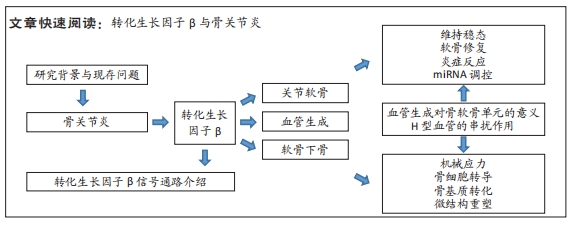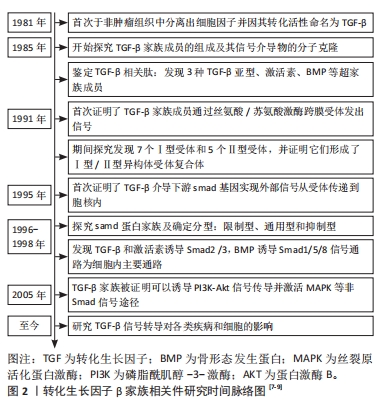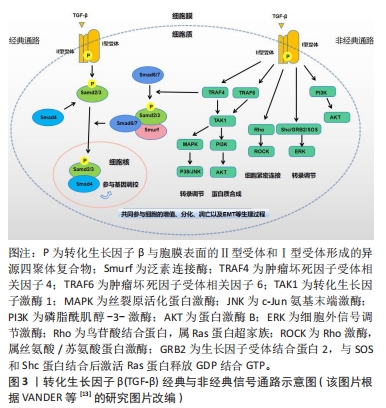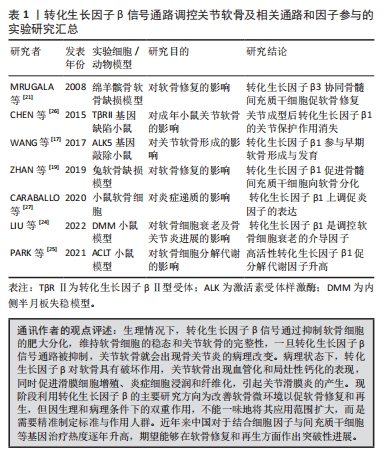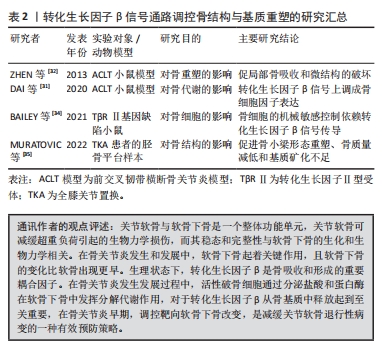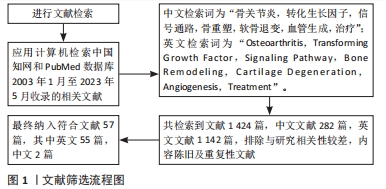[1] 张莹莹,李旭东,杨佳娟,等.中国40岁及以上人群骨关节炎患病率的Meta分析[J].中国循证医学杂志,2021,21(4):407-414.
[2] ZHANG Z, HUANG C, JIANG Q, et al. Guidelines for the diagnosis andtreatment of osteoarthritis in China (2019 edition). Ann Transl Med. 2020;8(19):1213.
[3] CHO Y, JEONG S, KIM H, et al. Disease-modifying therapeutic strategies in osteoarthritis: current status and future directions. Exp Mol Med. 2021;53(11): 1689-1696.
[4] HU W, CHEN Y, DOU C, et al. Microenvironment in subchondral bone: predominant regulator for the treatment of osteoarthritis. Ann Rheum Dis. 2021; 80(4):413-422.
[5] ZHANG L, WEN C. Osteocyte dysfunction in joint homeostasis and osteoarthritis. Int J Mol Sci. 2021;22(12):6522.
[6] YAO Q, WU X, TAO C, et al. Osteoarthritis: pathogenic signaling pathways and therapeutic targets. Signal Transduct Target Ther. 2023;8(1):56.
[7] ROBERTS AB, ANZANO MA, LAMB LC, et al. New class of transforming growth factors potentiated by epidermal growth factor: isolation from non-neoplastic tissues. Proc Natl Acad Sci USA. 1981;78(9):5339-5343.
[8] ROBERTS AB, ANZANO MA, WAKEFIELD LM, et al. Type beta transforming growth factor: a bifunctional regulator of cellular growth. Proc Natl Acad Sci USA. 1985; 82(1):119-123.
[9] MORIKAWA M, DERYNCK R, MIYAZONO K. TGF-β and the TGF-β family: context-dependent roles in cell and tissue physiology. Cold Spring Harb Perspect Biol. 2016;8(5):a021873.
[10] REN LL, LI XJ, DUAN TT, et al. Transforming growth factor-β signaling: from tissue fibrosis to therapeutic opportunities. Chem Biol Interact. 2023;369:110289.
[11] ALBRO MB, NIMS RJ, CIGAN AD, et al. Dynamic mechanical compression of devitalized articular cartilage does not activate latent TGF-β. J Biomech. 2013; 46(8):1433-1439.
[12] ZI Z. Molecular engineering of the TGF-β signaling pathway. J Mol Biol. 2019; 431(15):2644-2654.
[13] VANDER ARK A, CAO J, LI X. TGF-β receptors: in and beyond TGF-β signaling. Cell Signal. 2018;52:112-120.
[14] ZHANG YE. Non-smad signaling pathways of the TGF-β family. Cold Spring Harb Perspect Biol. 2017;9(2):a022129.
[15] LEE W, MILLER EY, ZHU H, et al. High frame rate deformation analysis of knee cartilage by spiral dualMRI and relaxation mapping. Magn Reson Med. 2023; 89(2):694-709.
[16] HARDY MJ, PU X, OXFORD JT. Purification and isolation of proteins from hyaline cartilage. Methods Mol Biol. 2023;2598:217-225.
[17] WANG Q, TAN QY, XU W, et al. Cartilage-specific deletion of Alk5 gene results in a progressive osteoarthritis-like phenotype in mice. Osteoarthritis Cartilage. 2017;25(11):1868-1879.
[18] DU X, CAI L, XIE J, et al. The role of TGF-beta3 in cartilage development and osteoarthritis. Bone Res. 2023;11(1):2.
[19] ZHAN X, CAI P, LEI D, et al. Comparative profiling of chondrogenic differentiation of mesenchymal stem cells (MSCs) driven by two different growth factors. Cell Biochem Funct. 2019;37(5):359-367.
[20] VAN DER KRAAN PM, BLANEY DAVIDSON EN, BLOM A, et al. TGF-beta signaling in chondrocyte terminal differentiation and osteoarthritis: modulation and integration of signaling pathways through receptor-Smads. Osteoarthritis Cartilage. 2009;17(12):1539-1545.
[21] MRUGALA D, BONY C, NEVERS N, et al. Phenotypic and functional characterisation of ovine mesenchymal stem cells: application to a cartilage defect model. Ann Rheum Dis. 2008;67(3):288-295.
[22] LIU S, DENG Z, CHEN K, et al. Cartilage tissue engineering: from proinflammatory and anti inflammatory cytokines to osteoarthritis treatments (Review). Mol Med Rep. 2022;25(3):99.
[23] ALI SA, GANDHI R, POTLA P, et al. Sequencing identifies a distinct signature of circulating microRNAs in early radiographic knee osteoarthritis. Osteoarthritis Cartilage. 2020;28(11):1471-1481.
[24] LIU L, ZHAO C, ZHANG H, et al. Asporin regulated by miR-26b-5p mediates chondrocyte senescence and exacerbates osteoarthritis progression via TGF-β1/Smad2 pathway. Rheumatology (Oxford). 2022;61(6):2631-2643.
[25] PARK JY, BAE HC, PVO SH, et al. TGFβ1-induced transglutaminase-2 triggers catabolic response in osteoarthritic chondrocytes by modulating MMP-13. Tissue Eng Regen Med. 2021;18(5):831-840.
[26] CHEN R, MIAN M, FU M, et al. Attenuation of the progression of articular cartilage degeneration by inhibition of TGF-β1 signaling in a mouse model of osteoarthritis. Am J Pathol. 2015;185(11):2875-2885.
[27] CARABALLO CB, COELHO TRP, DE HOLANDA AFONSO RC, et al. Osteoarthritic synovial fluid and TGF-β1 induce interleukin-18 in articular chondrocytes. Cartilage. 2020;11(3):385-394.
[28] LEE H, KIM H, SEO J, et al. TissueGene-C promotes an anti-inflammatory micro-environment in a rat monoiodoacetate model of osteoarthritis via polarization of M2 macrophages leading to pain relief and structural improvement. Inflammopharmacology. 2020;28(5):1237-1252.
[29] GAO J, REN P, GONG H. Morphological and mechanical alterations in articular cartilage and subchondral bone during spontaneous hip osteoarthritis in guinea pigs. Front Bioeng Biotechnol. 2023;11:1080241.
[30] ZHU X, CHAN YT, YUNG PSH, et al. Subchondral bone remodeling: a therapeutic target for osteoarthritis. Front Cell Dev Biol. 2021;8:607764.
[31] DAI G, XIAO H, LIAO J, et al. Osteocyte TGFβ1 Smad2/3 is positively associated with bone turnover parameters in subchondral bone of advanced osteoarthritis. Int J Mol Med. 2020;46(1):167-178.
[32] ZHEN G, WEN C, JIA X, et al. Inhibition of TGF-β signaling in mesenchymal stem cells of subchondral bone attenuates osteoarthritis. Nat Med. 2013;19(6):704-712.
[33] ZHEN G, GUO Q, LI Y, et al. Mechanical stress determines the configuration of TGFβ activation in articular cartilage. Nat Commun. 2021;12(1):1706.
[34] BAILEY KN, NGUYEN J, YEE CS, et al. Mechanosensitive control of articular cartilage and subchondral bone homeostasis in mice requires osteocytic transforming growth factor β signaling. Arthritis Rheumatol. 2021;73(3):414-425.
[35] MURATOVIC D, FINDLAY DM, QUARRINGTON RD, et al. Elevated levels of active transforming growth factor β1 in the subchondral bone relate spatially to cartilage loss and impaired bone quality in human knee osteoarthritis. Osteoarthritis Cartilage. 2022;30(6):896-907.
[36] SIMKIN PA. Marrow fat may distribute the energy of impact loading throughout subchondral bone. Rheumatology (Oxford). 2018;57(3):414-418.
[37] FINNILA MAJ, THEVENOT J, AHO OM, et al. Association between subchondral bone structure and osteoarthritis histopathological grade. J Orthop Res. 2017; 35(4):785-792.
[38] LI J, GE L, ZHAO Y, et al. TGF-β2 and TGF-β1 differentially regulate the odontogenic and osteogenic differentiation of mesenchymal stem cells. Arch Oral Biol. 2022; 135:105357.
[39] LI Y, LIEM Y, DALL’ARA E, et al. Subchondral bone microarchitecture and mineral density in human osteoarthritis and osteoporosis: a regional and compartmental analysis. J Orthop Res. 2021;39(12):2568-2580.
[40] CRANE JL, CAO X. Bone marrow mesenchymal stem cells and TGF-β signaling in bone remodeling. J Clin Invest. 2014;124(2):466-472.
[41] HU Y, CHEN X, WANG S, et al. Subchondral bone microenvironment in osteoarthritis and pain. Bone Res. 2021;9(1):20.
[42] ZHEN G, CAO X. Targeting TGFβ signaling in subchondral bone and articular cartilage homeostasis. Trends Pharmacol Sci. 2014;35(5):227-236.
[43] AKHAVAN S, MARTINKOVICH SC, KASIK C, et al. Bone marrow edema, clinical significance, and treatment options: a review. J Am Acad Orthop Surg. 2020; 28(20):e888-e899.
[44] PENG D, FU M, WANG M, et al. Targeting TGF-β signal transduction for fibrosis and cancer therapy. Mol Cancer. 2022;21(1):104.
[45] LINDSTROM E, RIZOSKA B, TUNBLAD K, et al. The selective cathepsin K inhibitor MIV-711 attenuates joint pathology in experimental animal models of osteoarthritis. J Transl Med. 2018;16(1):56.
[46] ZHOU X, CAO H, YUAN Y, et al. Biochemical signals mediate the crosstalk between cartilage and bone in osteoarthritis. Biomed Res Int. 2020;2020:5720360.
[47] KOIDE N, ODKHUU E, NAIKI Y, et al. Augmentation of LPS-induced vascular endothelial cell growth factor production in macrophages by transforming growth factor-β1. Innate Immun. 2014;20(8):816-825.
[48] KUROYANAGI G, OTSUKA T, YAMAMOTO N, et al. Resveratrol suppresses TGF-β-induced VEGF synthesis in osteoblasts: Inhibition of the p44/p42 MAPKs and SAPK/JNK pathways. Exp Ther Med. 2015;9(6):2303-2310.
[49] PEI YA, CHEN S, PEI M. The essential anti-angiogenic strategies in cartilage engineering and osteoarthritic cartilage repair. Cell Mol Life Sci. 2022;79(1):71.
[50] CUI Z, CRANE J, XIE H, et al. Halofuginone attenuates osteoarthritis by inhibition of TGF-β activity and H-type vessel formation in subchondral bone. Ann Rheum Dis. 2016;75(9):1714-1721.
[51] PENG Y, WU S, LI Y, et al. Type H blood vessels in bone modeling and remodeling. Theranostics. 2020;10(1):426-436.
[52] JI G, XU R, NIU Y, et al. Vascular endothelial growth factor pathway promotes osseointegration and CD31hiEMCNhi endothelium expansion in a mouse tibial implant model: an animal study. Bone Joint J. 2019;101-B(7_Supple_C):108-114.
[53] 王峰,徐佳,孔令驰,等.H型内皮细胞在成血管-成骨偶联中的作用[J].中华创伤骨科杂志,2020,22(7):641-644.
[54] WANG L, ZHOU F, ZHANG P, et al. Human type H vessels are a sensitive biomarker of bone mass. Cell Death Dis. 2017;8(5):e2760.
[55] SU W, LIU G, LIU X, et al. Angiogenesis stimulated by elevated PDGF-BB in subchondral bone contributes to osteoarthritis development. JCI Insight. 2020; 5(8):e135446.
[56] WANG R, XU B. TGFβ1-modified MSC-derived exosome attenuates osteoarthritis by inhibiting PDGF-BB secretion and H-type vessel activity in the subchondral bone. Acta Histochem. 2022;124(7):151933.
[57] LIU Y, XIE HQ, SHEN B. Type H vessels-a bridge connecting subchondral bone remodelling and articular cartilage degeneration in osteoarthritis development. Rheumatology (Oxford). 2023;62(4):1436-1444.
|
